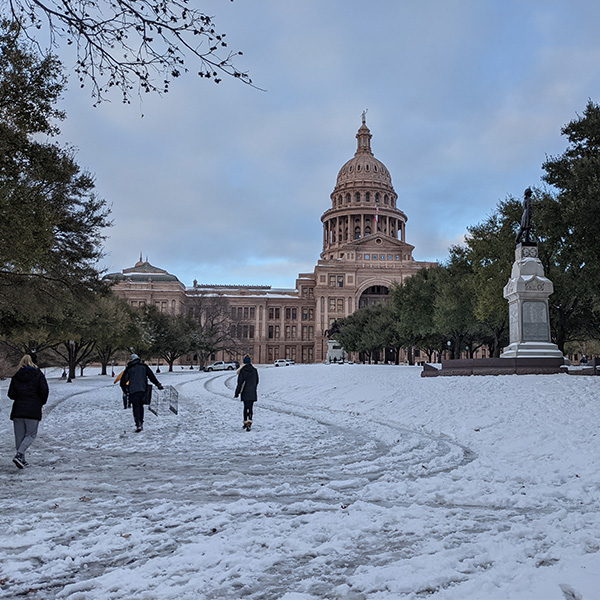
NERC CEO Jim Robb said Tuesday that his organization thinks more work will be needed to prepare the bulk power system for extreme winter events, even after the proposed cold weather standard (Project 2019-06) is finished.
“Our conclusion, and we think FERC will support this, is to get the standards as currently conceived in process, and then once we get through the inquiry and have all the insights that come out of that, to propose whatever amendments or adjustments to it would be required,” Robb said during a media roundtable. “But we wanted to get this basic framework in place right away.”
The cold weather standards are currently out for their second formal comment and ballot after falling short of the required two-thirds segment-weighted threshold required for approval on the first ballot that concluded last month. (See NERC Cold Weather Team to Seek Faster Finish.)
NERC’s Standards Committee agreed to shorten the comment period from the standard 45 days to 25 after the February winter storms that led to prolonged mass outages in Texas and the Midwest brought a new urgency to industry perceptions of winterization. (See ERCOT: Grid was ‘Seconds and Minutes’ from Total Collapse.)
In a webinar Wednesday, NERC Senior Standards Developer Jordan Mallory said the standard development team (SDT) is aiming to finish the cold weather standards in time to submit them to NERC’s Board of Trustees when it meets on June 11. That would give the team time for one more 25-day ballot period if the standards fail to receive industry approval again, though SDT leadership expressed confidence that their alterations in response to the last round of comments would move the standards toward industry acceptance.
Winter Storms Inquiry Making Steady Progress
Robb agreed that the “extraordinary events of February” had helped to spotlight the shortcomings of current weatherization practices. As a result, he expects “industry to respond very aggressively” once the new standards are approved, even though they will likely not be enforceable until next year. However, he also observed that the project was already under way before the February storms, and its proposals are relatively modest in light of the problems revealed in the crisis.
Uncovering those issues, and the additional changes that may be needed to address them, is the goal of the joint inquiry announced by FERC and NERC as the mass outages were still underway. (See “FERC, NERC Announce Joint Inquiry,” Slow Storm Restoration Sparks Anger in Texas, South.) In Tuesday’s roundtable, Robb said that inquiry is still “relatively early in the process,” but that the organizations hope to have “a good draft available by Labor Day.”
While the urgency of resolving BPS winter preparedness issues is undeniable, Robb reminded listeners that February’s winter storms affected five out of NERC’s six regional entities, not just Texas. Load-shedding was even required in “extraordinarily well-winterized” areas such as the Dakotas, for example, and all types of generation were impacted by the cold, indicating the need for a comprehensive review of the system’s failings.
“What we want to do is [to] understand all the root causes of the generation not being there, and then [ask] what actions, what lessons do you learn … that could have prevented the situation from happening, or at least happening to the extent and magnitude that it did,” Robb said.
“What we’re not going to be focusing on [is] the pricing and the market-related issues,” he continued, adding that FERC may conduct a separate inquiry on that topic. “[We’re] going to be focused primarily on the physical operation of the system and why they weren’t able to serve the load that was there.”
Industry Not a Target in SolarWinds Hack
Tuesday’s event also featured an update from Manny Cancel, NERC senior vice president and CEO of the Electricity Information Sharing and Analysis Center (E-ISAC), on industry exposure to the SolarWinds breach.
Cancel said NERC experienced an “overwhelming response” to its Level 2 alert, issued after the breach of SolarWinds’ Orion network management platform was discovered late last year, indicating that the industry recognized the “criticality” of the breach. More than 18,000 public- and private-sector organizations, including the Department of Energy and FERC, are known to have downloaded the infected software, which provided a backdoor through which the responsible hackers (likely Russian in origin, according to the government) could gain visibility into victims’ information technology networks.
The good news is that the electricity sector “did not appear to be a target of this attack,” Cancel said. Although about one in four of the 1,500 respondents reported that they or their third-party service providers had downloaded the infected Orion software, none of them reported any indicators of follow-on actions by the hackers.
Asked if the responses suggested any patterns among affected entities, Cancel said those organizations that reported compromise “generally trended toward larger organizations,” which he attributed to the fact that the Orion platform is primarily intended to manage “large IT and telecommunications networks.”
Overall, the last 18 months represented an “unprecedented” period of cyber threats, Cancel said, with increasingly aggressive hacking activity meeting a “broader opportunity” created by the increase in remote work caused by the pandemic. The fact that utilities managed to keep essential services functioning is a testament to the hard work and communication of cybersecurity experts across sectors, he said.
“One of the things that I’m most proud of over the past year is that the membership in the E-ISAC actually increased by 25% in 2020,” Cancel said. “And a significant number of that increase comes from partner organizations. These are partnerships with other ISACs, government agencies, vendors and other trade organizations. And I think really it’s a testament to the value of the information that the E-ISAC provides.”




